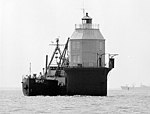Magothy River
Rivers of Anne Arundel County, MarylandRivers of MarylandTributaries of the Chesapeake Bay
The Magothy River runs 12.1 miles (19.5 km) through Anne Arundel County in the U.S. state of Maryland. It is located south of the Patapsco River and north of the Severn River. There are two public park paddling access points, Beachwood Park on the north shore a half mile east of the Magothy Bridge Road bridge, and Spriggs Farm Park off Bayberry Drive, on the south shore two miles west of the Magothy's mouth. Both are Anne Arundel County parks.
Excerpt from the Wikipedia article Magothy River (License: CC BY-SA 3.0, Authors).Magothy River
Broadwater Road,
Geographical coordinates (GPS) Address Nearby Places Show on map
Geographical coordinates (GPS)
| Latitude | Longitude |
|---|---|
| N 39.056111111111 ° | E -76.434444444444 ° |
Address
Broadwater Road
Broadwater Road
21056
Maryland, United States
Open on Google Maps






